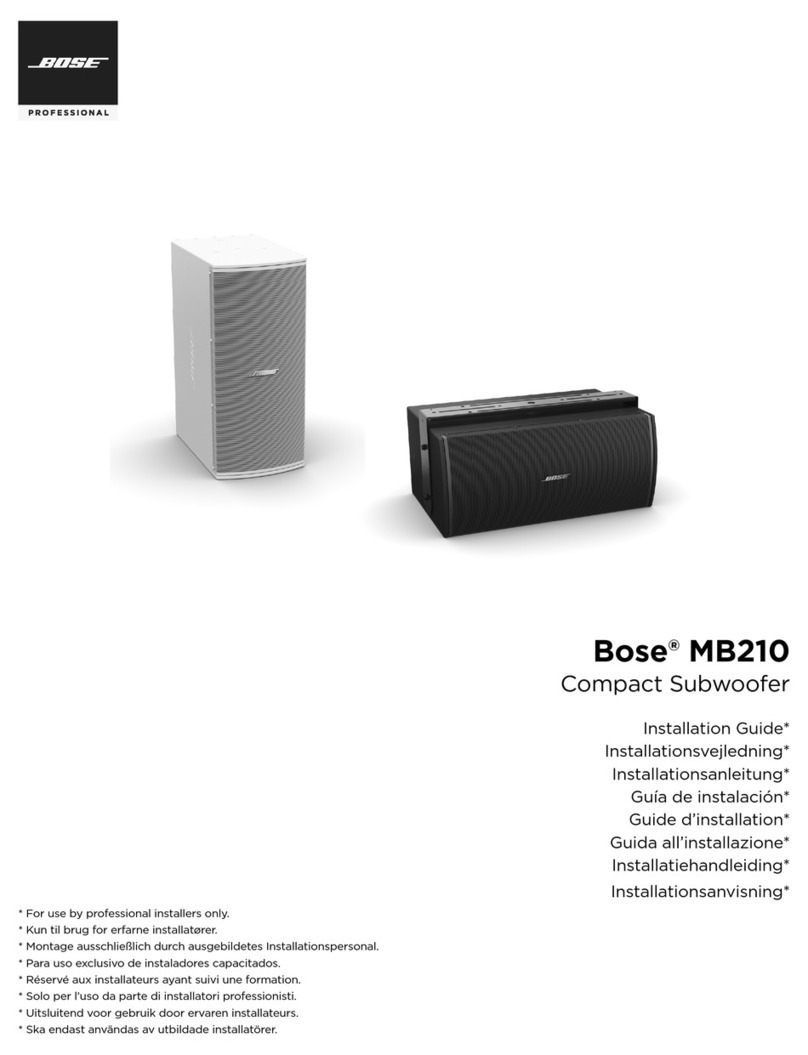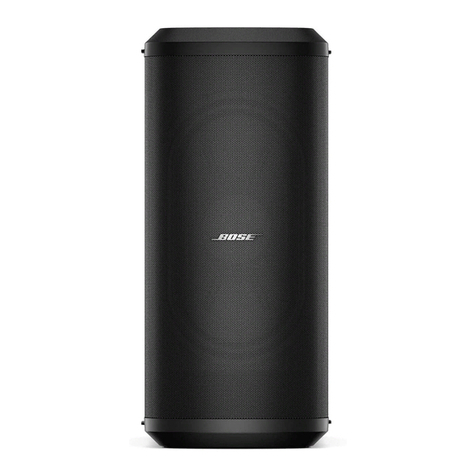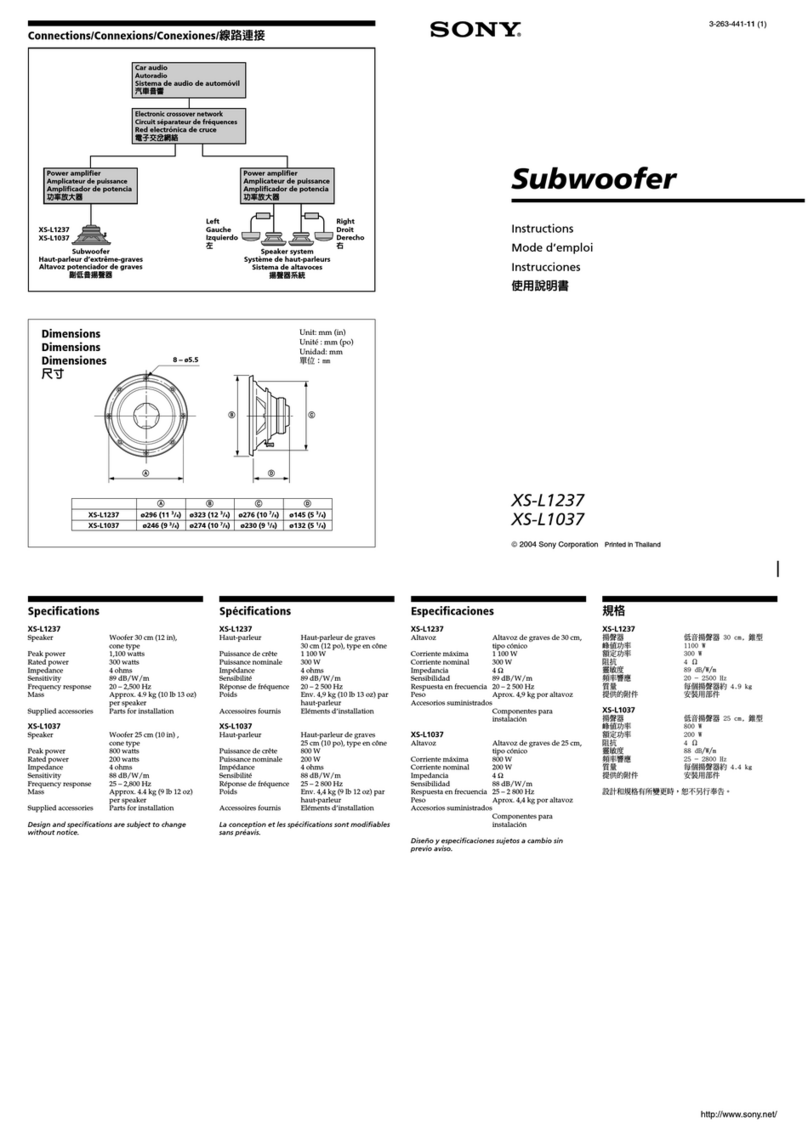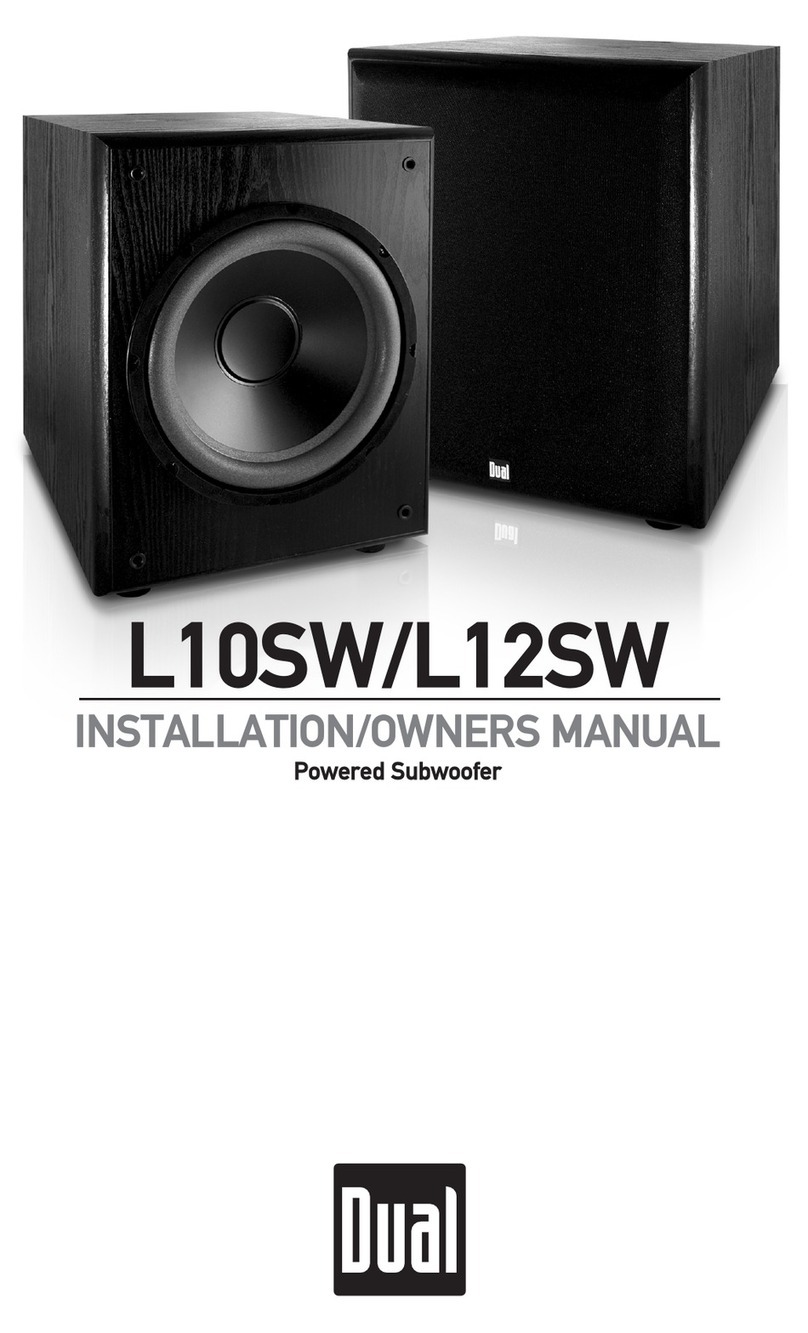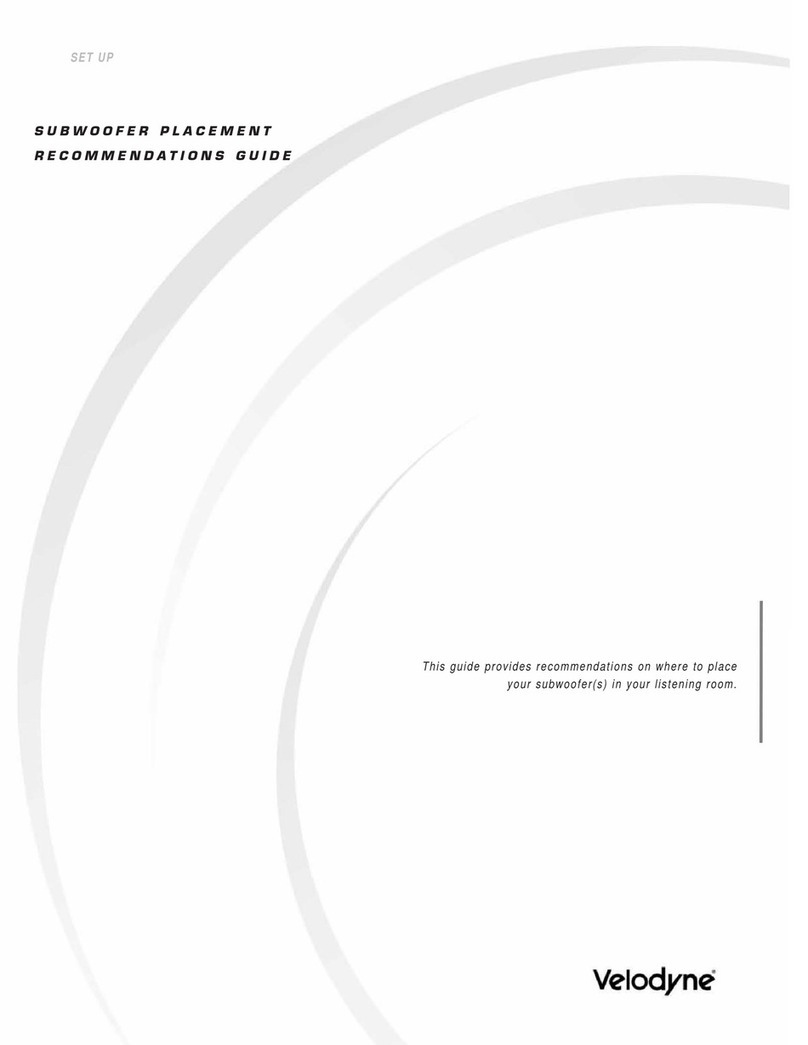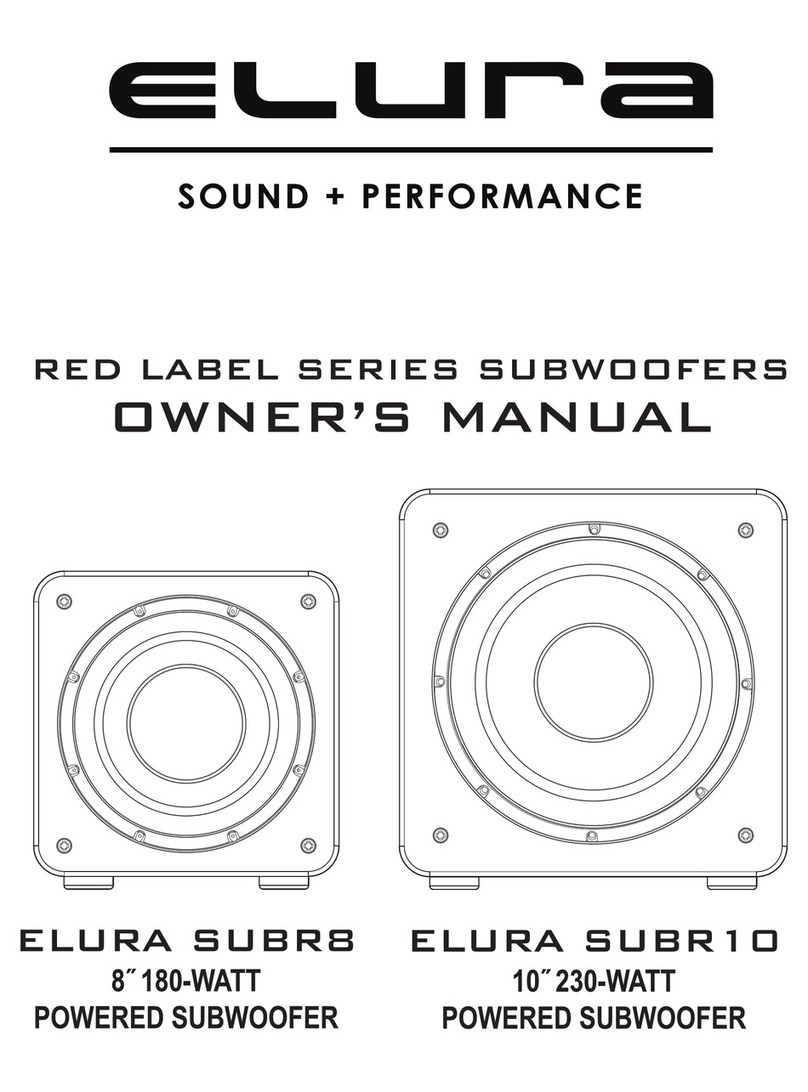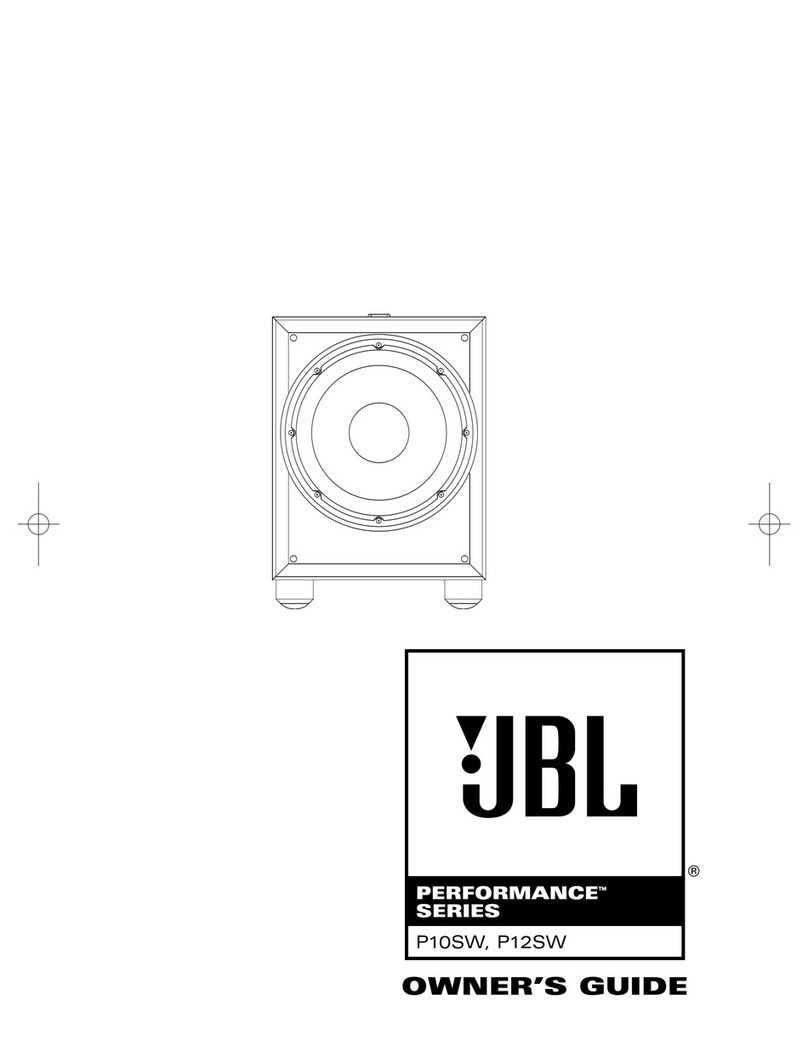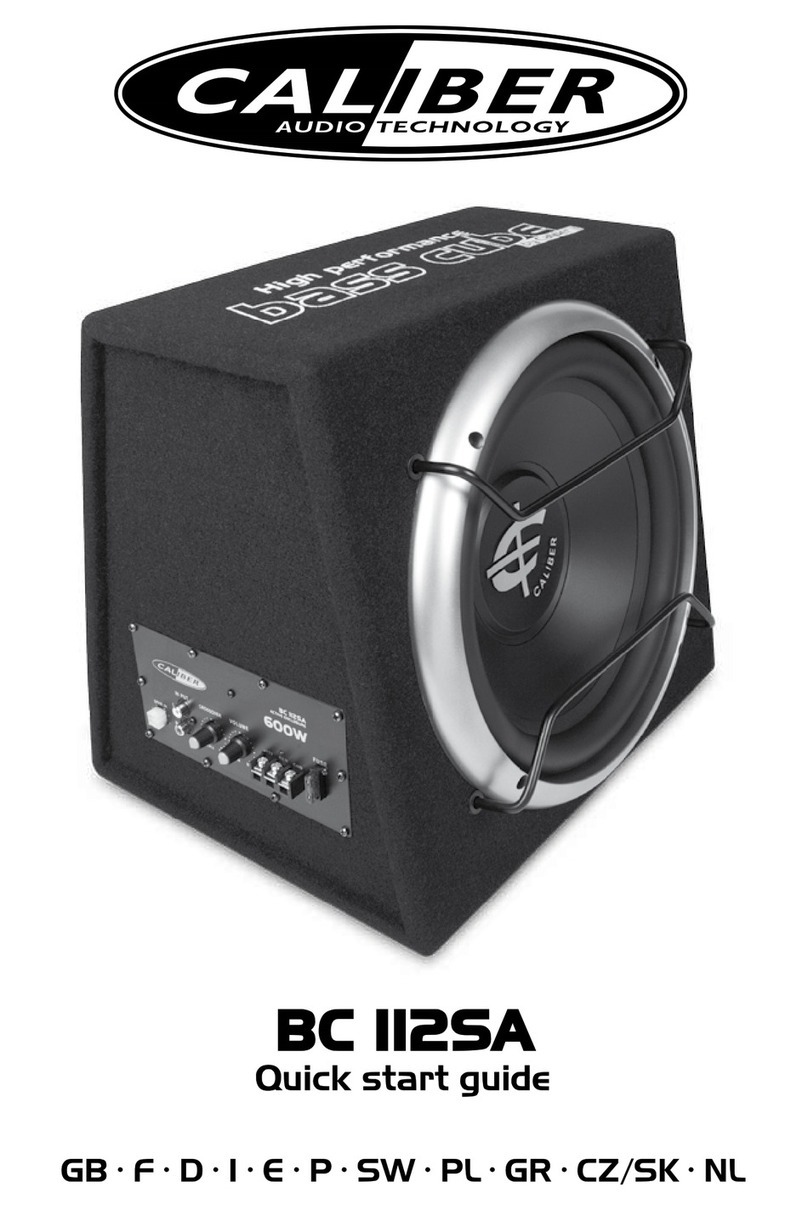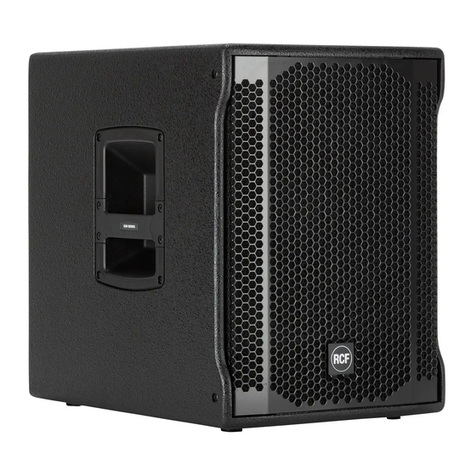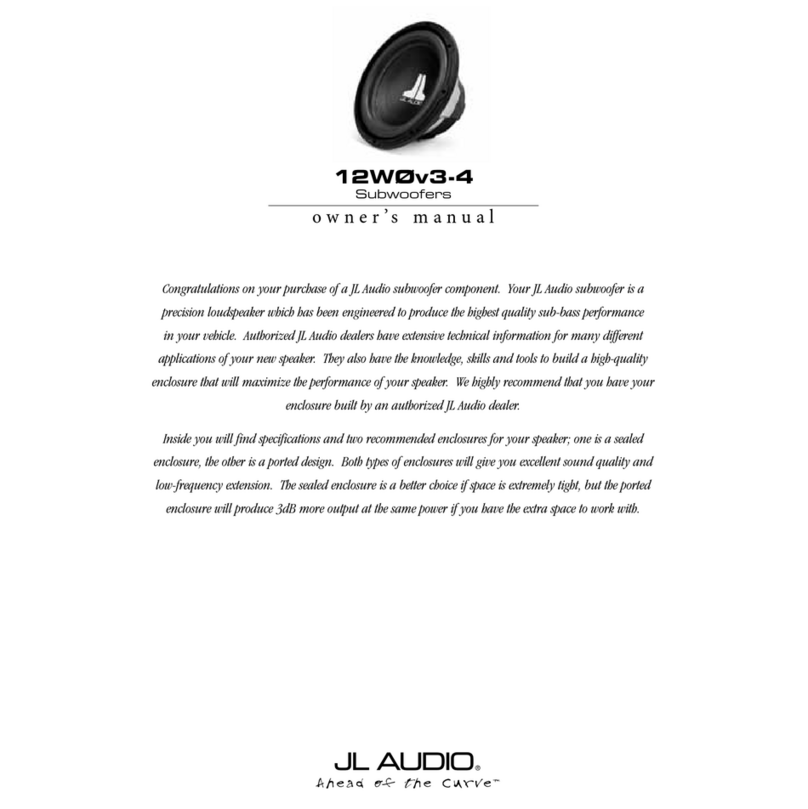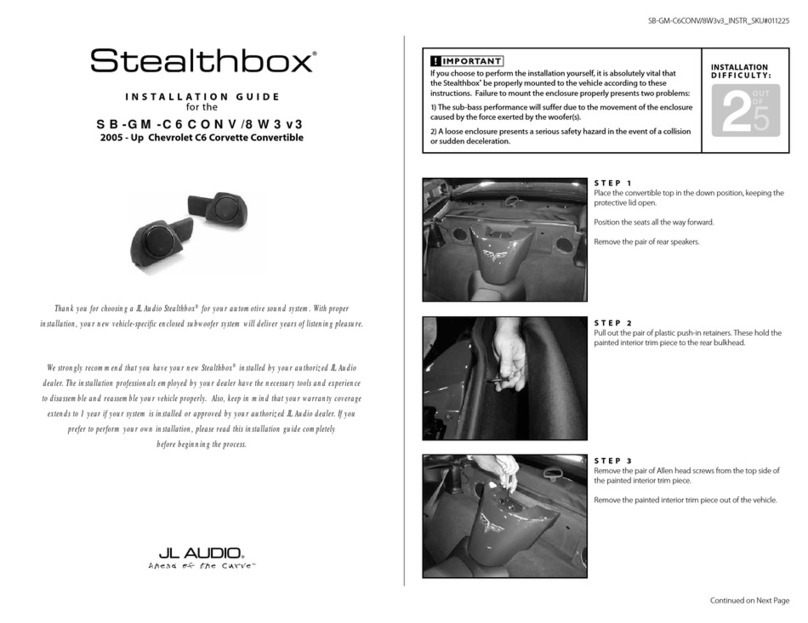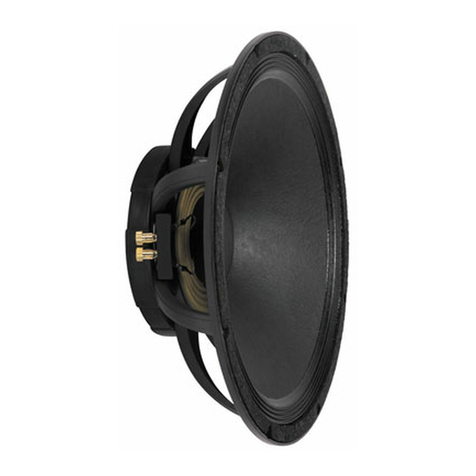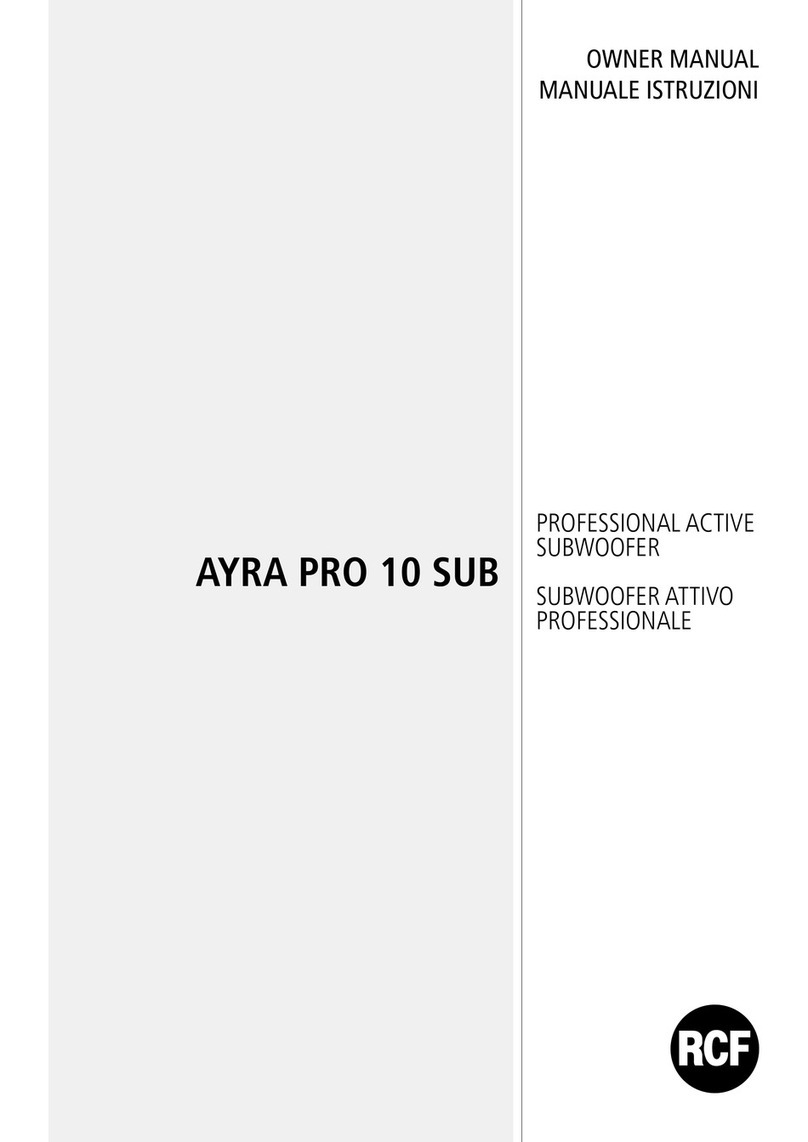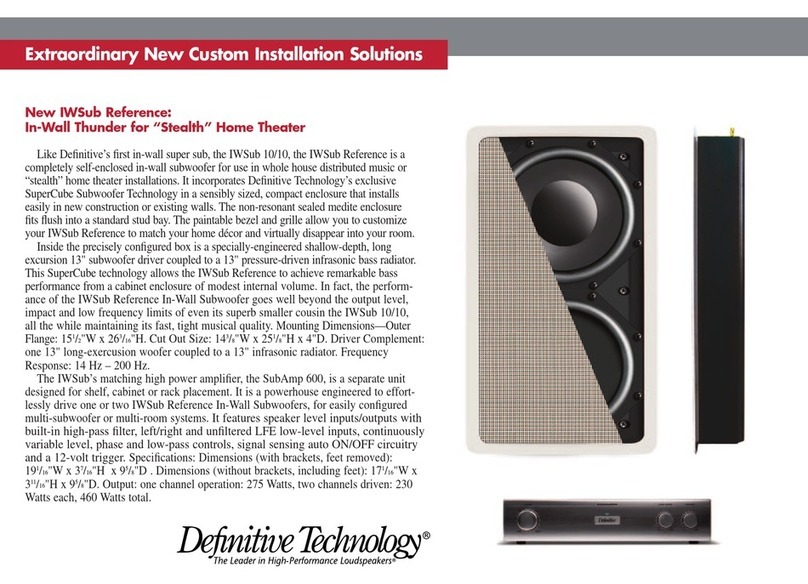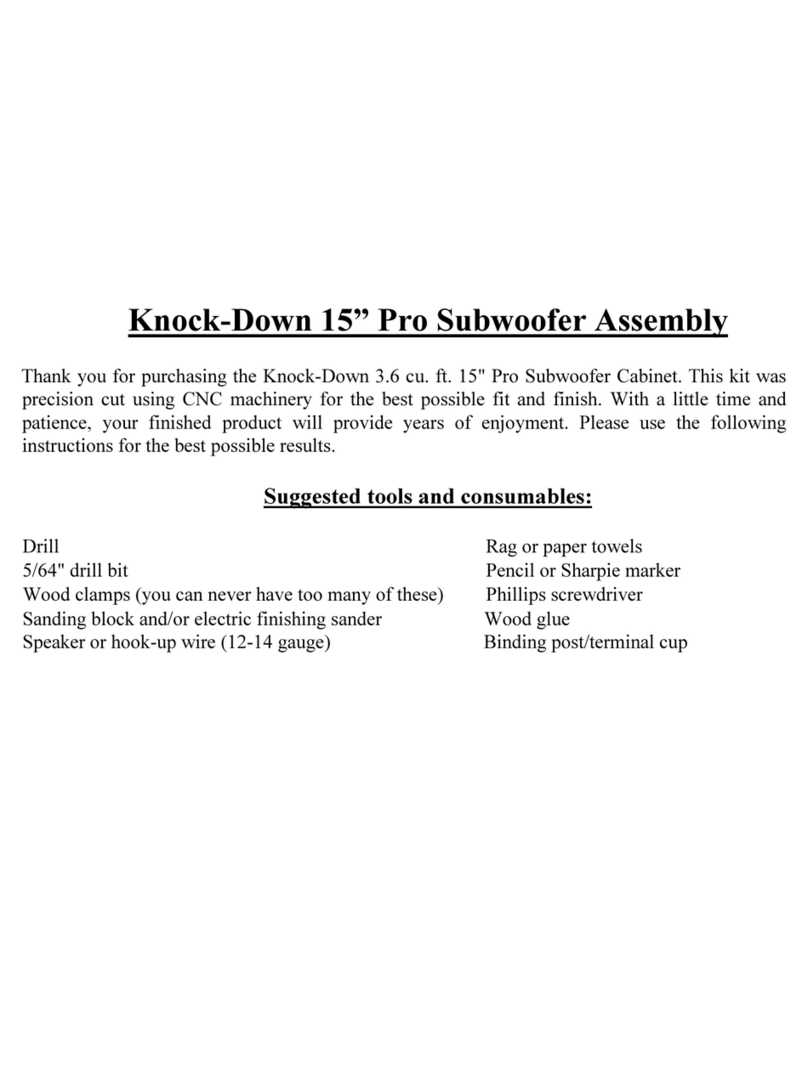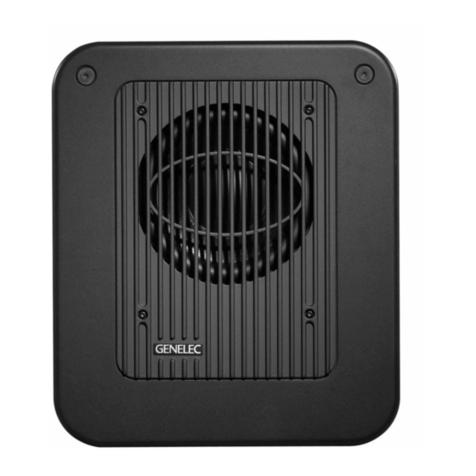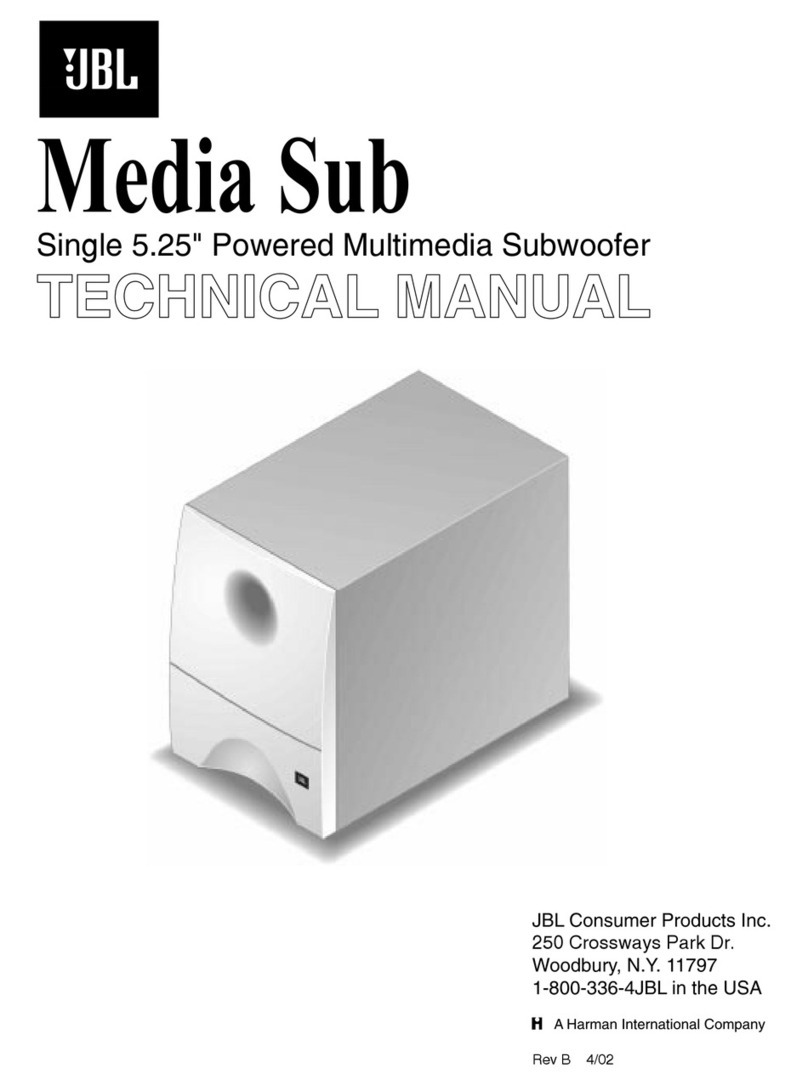Bose Loewe Concertos Acoustimass 61247 User manual

230-90375.915
Troubleshooting Guide
Test Procedures
Scope Photos
Computer Setup Procedure
Concertos
Acoustimass ®
Bassmodul
Art.-Nr. 61247
SOUND BY
BOSE ®

1
Troubleshooting Guide Overview
This troubleshooting guide is divided into three sections. The section that you use will be
determined by the items available to you for use in troubleshooting. Section 1 allows for limited
troubleshooting due to limited availability of items. Section 3 is the most complete troubleshooting
section.
Section 1: Bass Box Only Procedures is to be used if you have a bass module to troubleshoot,
but no head unit or PC to turn the bass module on. It will ta e you through a troubleshooting
process which will allow you to power up the amplifier PCB by itself, as well as some troubleshoot-
ing procedures for the Digital Signal Processor PCB, should it be at fault.
Section 2: Bass Box with a Head Unit Procedures is to be used if you have a bass module and
a head unit, but no PC. In this section you will be able to connect an audio signal to the head unit
and turn the bass module on. This will allow you to signal trace and troubleshoot the amplifier PCB
and the Digital Signal Processor PCB.
Section : Computer Aided Troubleshooting Procedures is to be used if you have a PC
that can be used to communicate with the Digital Signal Processor PCB of the bass module,
and is the preferred method of troubleshooting. In this section you will be able to determine the
EQ curve of the module under test as well as put the module into different test modes for easier
troubleshooting.
There is an Appendix at the bac of this guide containing information such as simplified
schematic diagrams, bloc diagrams, frequency response curves, tables, and computer setup
information. See the table of contents for a complete listing.

2
Table of Contents
Troubleshooting Guide Overview ....................................................................................................1
Table of Contents .......................................................................................................................... 2-
Section 1, Bass Box Only Procedures....................................................................................... 4-21
Section 1 Contents............................................................................................................................4
Test Set-up Parameters and Equipment .........................................................................................5
Bass Box Only Troubleshooting Procedures..................................................................................5
Bass Box Only Test Procedures .................................................................................................. 6-7
Figure 1. Scope Photo of Boot Prompt at J5 Pin 11..........................................................................7
Amplifier PCB Hook-Up Procedures ......................................................................................... 8-11
Figure 2. Cable for Amplifier Output Connection at J701 ..................................................................8
Figure 3. Output Wire Connection View at J701 ...............................................................................8
Figure 4. Input Wire Connection View at J700 ..................................................................................9
Figure 5. Triac Jumping View on DSP PCB .....................................................................................10
Amplifier Test Procedures ..............................................................................................................12
DSP PCB Troubleshooting Procedures ................................................................................... 1 -19
Figure 6. Codec to DSP, Digital Audio Signal Path ..........................................................................17
Figure 7. Micro to/from DSPs..........................................................................................................17
Figure 8. DSP PCB Test Point Locations Layout Diagram, Solder Side ..........................................19
Scope Photos ............................................................................................................................ 20-21
Figure 9. Codec (U100) Scope Photo, Mute Condition ...................................................................20
Figure 10. Microcontroller (U202) Scope Photo, Power Up ............................................................21
Figure 11. Microcontroller 8 MHz cloc at U202 pin 39...................................................................21
Section 2, Bass Module with Head Unit Procedures.............................................................. 22-41
Section 2 Contents..........................................................................................................................22
Normal System Operation Description .........................................................................................2
Test Setup Procedures ...................................................................................................................24
Connection of Bass Module Using a CD-5/CD-20 Music Center.................................................24
Bass Box Troubleshooting Procedures................................................................................... 25-
Figure 12. Scope Photo of Boot Prompt at J5 Pin 11......................................................................26
Figure 13. Codec to DSP, Digital Audio Signal Path........................................................................ 2
Figure 14. Micro to/from DSPs ........................................................................................................ 2
DSP PCB Troubleshooting.............................................................................................................. 4
Figure 15. DSP PCB Test Point Locations Layout Diagram, Solder Side ........................................ 4
Scope Photos ............................................................................................................................ 5-41
Figure 16. Codec (U100) Scope Photo, Un-mute Condition ........................................................... 5
Figure 17. Codec (U100) Scope Photo, Mute Condition ................................................................. 6
Figure 18. Microcontroller (U202) Scope Photo, Power Up ............................................................ 7
Figure 19. SPDIF Signal at U100 pin 42 ......................................................................................... 8
Figure 20. Microcontroller 8 MHz cloc at U202 pin 39................................................................... 8
Figure 21. Codec 11.2896 MHz Cloc ............................................................................................ 9
Figure 22. 40 MHz DSP cloc ......................................................................................................... 9
Figure 23. 3.3V Switching Power Supply Signals............................................................................40
Figure 24. Power Up Condition at U202 Pin 25...............................................................................40
Figure 25. Transmit Frame Sync .....................................................................................................41
Figure 26. Serial Data Cloc ...........................................................................................................41
Figure 27. Audio Data .....................................................................................................................41
Section , Computer Aided Troubleshooting .......................................................................... 42-64
Section Contents..........................................................................................................................42
Test Setup Parameters and Equipment.........................................................................................4
Test Setup Procedure .....................................................................................................................4

3
Table of Contents (continued)
Troubleshooting Procedures ................................................................................................... 44-57
Figure 28. 25 Pin to 9 Pin Serial Data Cable...................................................................................44
Figure 29. DSP PCB Test Point Locations Layout Diagram, Solder Side ........................................44
Figure 30. Scope Photo of Boot Prompt at J5 Pin 11......................................................................47
Figure 31. Codec to DSP, Digital Audio Signal Path........................................................................56
Figure 32. Micro to DSPs ................................................................................................................56
Scope Photos ............................................................................................................................ 58-64
Figure 33. Codec (U100) Scope Photo, Un-mute Condition ...........................................................58
Figure 34. Codec (U100) Scope Photo, Mute Condition .................................................................59
Figure 35. Microcontroller (U202) Scope Photo, Power Up ............................................................60
Figure 36. SPDIF Signal at U100 pin 42 .........................................................................................61
Figure 37. Microcontroller 8 MHz cloc at U202 pin 39...................................................................61
Figure 38. Codec 11.2896 MHz Cloc ............................................................................................62
Figure 39. 40 MHz DSP cloc .........................................................................................................62
Figure 40. 3.3V Switching Power Supply Signals............................................................................6
Figure 41. Power Up Condition at U202 Pin 25...............................................................................6
Figure 42. Transmit Frame Sync .....................................................................................................64
Figure 43. Serial Data Cloc ...........................................................................................................64
Figure 44. Audio Data .....................................................................................................................64
Appendix .................................................................................................................................... 65-87
Computer Setup Procedure ..................................................................................................... 65-66
Figure 45. Test Setup Diagram........................................................................................................68
Figure 46. Fault Circuits ..................................................................................................................69
Figure 47. DSP PCB and Amplifier PCB Interconnection Diagram .................................................70
Figure 48. DSP PCB Basic Bloc Diagram .....................................................................................71
Figure 49. DC Power Supplies Simplified Schematic Diagram .......................................................71
Figure 50. Protection Circuit Simplified Schematic Diagram ...........................................................72
Figure 51. Microcontroller U202 Basic Bloc Diagram ....................................................................7
Figure 52. Satellite Amplifier DC Offset Detector Simplified Schematic Diagram ...........................7
Figure 53. Analog Signal Path from Input Jac s to Codec Simplified Schematic Diagram .............74
Figure 54. Digital Signal Path from Input Jac to Codec Simplified Schematic Diagram ................74
Figure 55. Analog Signal Path from Codec to Satellite Simplified Schematic Diagram...................75
Figure 56. Transformer Wiring Diagram ..........................................................................................75
Figure 57. Digital Bass Module Overall Turn-on Circuit Schematic Diagram ..................................76
Figure 58. Lifestyle® 12 and 25 Series II Overall Frequency Response Curve ...............................77
Figure 59. Lifestyle® 30 Series II Overall Frequency Response Curve ...........................................77
Figure 60. Lifestyle® Series II Tone Control Frequency Response Curve .......................................78
Figure 61. Lifestyle® Series II Film EQ Frequency Response Curve ..............................................78
Figure 62. Lifestyle® Series II Dynamic EQ Frequency Response Curve .......................................79
Figure 63. Lifestyle® Series II 240 Volt Bass Frequency Response Curve......................................79
SPDIF................................................................................................................................................80
TTL to RS2 2 Converter .................................................................................................................80
TAP Commands ......................................................................................................................... 80-81
Hex Notation ....................................................................................................................................82
Firmware CHECKSUMS ..................................................................................................................82
Diagnostic voltages available at the uC ADC ports .....................................................................8
Two digit hex to voltage conversion ........................................................................................ 8 -86
Thermistor readings (TAP command “ad2”) ........................................................................... 86-87

4
Section 1
Bass Box Only Procedures
Section 1 Contents
Section 1, Bass Box Only Procedures....................................................................................... 4-21
Test Set-up Parameters and Equipment .........................................................................................5
Bass Box Only Troubleshooting Procedures..................................................................................5
Bass Box Only Test Procedures .................................................................................................. 6-7
Figure 1. Scope Photo of Boot Prompt at J5 Pin 11..........................................................................7
Amplifier PCB Hook-Up Procedures ......................................................................................... 8-11
Figure 2. Cable for Amplifier Output Connection at J701 ..................................................................8
Figure 3. Output Wire Connection View at J701 ...............................................................................8
Figure 4. Input Wire Connection View at J700 ..................................................................................9
Figure 5. Triac Jumping View on DSP PCB .....................................................................................10
Amplifier Test Procedures ..............................................................................................................12
DSP PCB Troubleshooting Procedures ................................................................................... 1 -19
Figure 6. Codec to DSP, Digital Audio Signal Path ..........................................................................17
Figure 7. Micro to/from DSPs..........................................................................................................17
Figure 8. DSP PCB Test Point Locations Layout Diagram, Solder Side ..........................................19
Scope Photos ............................................................................................................................ 20-21
Figure 9. Codec (U100) Scope Photo, Mute Condition ...................................................................20
Figure 10. Microcontroller (U202) Scope Photo, Power Up ............................................................21
Figure 11. Microcontroller 8 MHz cloc at U202 pin 39...................................................................21
Click here to return to the main table of contents

5
Use the disassembly/assembly procedures found in the AM25/30P Series II service manual part
number 230-90374.921, to access the PCBs.
Speaker Output Loading:
Unless testing the amplifier for its rated power output, all tests are to be performed with the
spea er outputs unloaded. The amplifier can be tested with loads as long as the PCB is still
mounted in its heatsin .
Left Front Output: 8 Ohm, 1%, 50W
Right Front Output: 8 Ohm, 1%, 50W
Center Output: 8 Ohm, 1%, 50W
Left Surround Output: 8 Ohm, 1%, 50W
Right Surround Output: 8 Ohm, 1%, 50W
Bass Channel Output: 4 Ohm, 1%, 100W
Equipment Requirements:
Test Cable part number 169-90377.906
Test Set-up
1. Set up the bass box as shown in the Test Setup Diagram, (Figure 45. in the Appendix)
Note: Since you have only the bass box for troubleshooting and are not using a PC to
communicate with the module, you will not use the connectors for the PC, the audio jac s or the
digital input jac on the test cable. You will use the 3.5mm mono jac and the 9 Volt battery to turn
the module on.
When the module is powered on using the battery or a DC power supply, it will come up with
the amplifiers muted. You will not be unmuting the amplifiers and passing an audio signal while
performing the tests in this section.
If the module passes the tests in this section, you can use the amplifier test procedures to test the
amplifier board on its own and verify that it is o ay.
Test Set-up Parameters and Equipment
Bass Box Only Troubleshooting Procedures
1. Module Power-up
1.1 With the top cover removed and the line cord connected to an AC mains source, connect the 9
Volt battery to the 3.5 mm mono plug, TIP (+) RING (-), located on the test cable. This will power
up the module.
Note: If you disconnect AC mains from the module, you will need to disconnect and reconnect
the 9 Volt battery to the 3.5 mm plug to get the module to power up again.
2. Check for Voltage at the Transformer
2.1 Chec for voltage at the transformer secondary. If there is voltage at the transformer
secondary, s ip to procedure 4. If there is no voltage on the transformer secondary, continue on
to step 2.2.

6
2.2 Chec for AC mains voltage, 120 or 240 VAC at the transformer primary. If there is voltage at
the transformer primary, remove AC mains power and chec the thermal fuse in the transformer
primary. Replace the transformer if the internal fuse is open.
If there is no voltage at the transformer primary, proceed as follows.
2.2.1 Chec the fuse located on the PCB.
2.2.2 Ensure that the 18 conductor ribbon cable is fully seated.
2.2. With the line cord connected, connect the 10V turn-on signal to the 3.5 mm mono plug
located on the test cable. Chec the voltage at U300 pin 1.
If it is ~1.25 VDC, U300 should be on, turning triac D302 on. Go to procedure 4.
If it is ~0.8 VDC, the opto-coupler U300 is crowbarred off eeping triac D302 off, which connects
AC mains voltage to the transformer primary. Disconnect power to the bass module and go to
procedure 3.
. U 00 Crowbarred Off, Triac D 02 Off
Note: Refer to Figure 50. Protection Circuit Simplified Schematic Diagram in the Appendix for an
overview of the protection circuit.
.1 If the bass module crowbars off (shuts off) immediately (<50 msec) after applying the 10V
turn-on signal, chec the “protect” signal at J8 pin 6. If the voltage on J8 pin 6 is greater than
approximately +0.7 VDC, it will turn on Q202 and if the voltage is less than approximately -0.7V,
it will turn on Q203. Turning on either Q202 or Q203 causes Q202 and Q203 to latch and this will
activate the crowbar. If there is a fault condition at J8 pin 6, chec the ±12 VDC, ±17 VDC and ±34
VDC power supplies. If the ±12 VDC power supply is not wor ing and the ±34 VDC power supply
is wor ing, chec resistive fuses R714 and R713 located on the amplifier PCB. A failed component
could be causing one or more of these supplies to sag, causing the unit to crowbar off. If the DC
power supplies are wor ing, continue onto step 3.2.
.2 DC offset at the output of the bass amplifier J703 pin 2 (+) and pin 1 (-) will produce a fault
condition ‘protect” voltage (greater than approximately ± 0.7 VDC) at J8 pin 6. Chec the compo-
nents in the bass amplifier with an Ohmmeter.
. If the bass module crowbars off after approximately 3 seconds, there could be DC offset on
one or more satellite outputs. The satellite outputs are summed through the “spea er output DC
offset” circuit (SD251571, grid location A7). The output of this circuit, P66, is sent to the
microcontroller U202 pin 25. In normal operation, the voltage at U202 pin 25 should be 2.5 VDC.
If the voltage strays more than 1 VDC from the normal 2.5 VDC, microcontroller U202 pulls pin 39
(P22) to ground (normally high impedance) pulling R308 to ground latching the circuit consisting of
Q302 and Q303 (SD251571, grid location B4). This latch circuit, when latched, will shut off the
opto-isolator U300, which will shut off the triac D302 disconnecting AC from the primary of the
transformer.
Note: U202 pin 26 is connected to U202 pin 39. The head unit does not send an “ON” command
to the bass module. The uC nows when the power has just come up by watching the status of the
10V turn-on voltage via pin 26, which is connected to the same circuit mentioned above that the
uC uses to shut down the triac.
.4 If everything chec s out up to this point and the bass module is not crowbarred off, then go to
procedure 4.
Bass Box Only Test Procedures

7
4. Microprocessor Circuit Check
4.1 The serial data output leaves the DSP PCB at J5 pin 11 (U202 pin 43, signal name “TTY
OUT”) and the boot prompt can be chec ed here at power-up with an oscilloscope. The first thing
the uC is supposed to do when it comes out of reset is to print the following to the “debug” output
J5 pin 11.
**
%0001#01
This is visible as two bursts of activity. One immediately following the rising edge of the RESET
line (**) and one about 50 msec later (%0001#01). After printing the boot prompt, the uC will only
print error codes. Thus, a lac of activity on this signal after the initial two bursts is expected. Short
bursts of activity is li ely to be the uC printing out an error code. Refer to Figure 1.
Upper trace: RESET (active low) pulse U202 pin 14 or U200 pin 2
Middle trace: +5V supply
Lower trace: Serial data from uC, J5 pin 11
Figure 1. Scope Photo of Boot Prompt at J5 Pin 11
4.2 If there is no boot prompt at U202 pin 43, then chec for the following; +5 VDC at U202 pin 40
and U202 pin 18, 8 MHz cloc on both sides of X600, reset pulse at power-up at U202 pin 14.
If the +5 VDC, 8 MHz cloc and reset pulse are o ay and there is no boot prompt, then the uC
has failed. Replace the uC U202.
4. If everything loo s o ay up to this point, you can go to the amplifier hoo up procedures and
the amplifier test procedures to test the amplifier board on its own if you suspect it is the problem.
If you suspect the DSP board, you can go to the DSP troubleshooting procedures to further
troubleshoot the DSP board, or you can send it in for repair or replacement.
Bass Box Only Test Procedures

8
Figure 2. Cable for Amplifier Output Connection at J701
This procedure will allow you to connect and operate the amplifier PCB by itself, with no DSP
board connected. This will enable you to determine whether the amplifier PCB or the DSP PCB
is defective.
If you can turn the the amplifier PCB on, and perform the test procedures later in this section, then
the amplifier PCB should be fine and the DSP board is most li ely at fault. You can isolate the
failure on the DSP board further using the DSP troubleshooting procedures later in this section.
Below is a picture of the cable for the audio outputs on the amplifier PCB which will be connected
to J701 on the amp PCB. This cable can be built using the interconnect cable, Loewe part number
169-90370.992, and soldering wires to the connector end.
Amplifier PCB Hook-Up Procedures
Figure . Output Wire Connection View at J701
169-90370.992

9
Amplifier PCB Hook-Up Procedures
Figure 4. Input Wire Connection View at J700
1. Remove the top cover assembly using the disassembly/assembly procedures located in the
service manual part number 90374.921. The first PCB board you see is the DSP PCB (it has a shield
on it). Disconnect the gray interconnect cable from the top PCB. Disconnect the white ribbon cable
from the bottom PCB (amplifier board).
2. Connect individual 22 AWG, solid core wires to connector J700 at the L/R/C/LS/RS output jac .
This is the location where the white ribbon cable was connected. Connect the 8-wire test cable
(see Figure 2) to the 8-wire gray cable coming from the amplifier PCB. Refer to Figure 4 and the
Input Connector Table on page 11 for the following instructions. Connect a wire to pins 2, 3 and 4
of the connector J700. These are the mute lines used for un-muting the amplifier outputs. Connect
individual wires to pins 12 (right channel), 10 (left channel), 9 (center channel), 8 (bass channel),
7 (left surround) and 6 (right surround). Leave the woofer connector where it is. You should con-
nect the wires one channel at a time. Connect a single wire to pin 11 for a signal ground and
connect a jumper wire from the audio signal ground to the shield on the DSP PCB.

10
Figure 5. Triac Jumping View on DSP PCB
. Jumper point A to point B on the PCB as shown in Figure 5 below. Point A is the fuse clip and
Point B is J7 pin 1. There are two versions of the Triac, one is a through hole device and the other
is a surface mount device. This procedure will wor with either version.
4. Connect an oscilloscope to the pair of wires for the channel under test as wired in step 2.
Refer to the Output Connector Table on page 11 for the for a listing of the correct pair of wires to
test the channel desired (L, R, C, LS or RS).
5. Apply a 250 Hz, 63 mVrms signal to the input wires connected in step 2, and connect the audio
signal generator ground to pin 11 and the shield.
6. Apply AC mains voltage to the AC input jac . Be careful around the connector J7 on the top
PCB. This connector has the line voltage on it.
7. Connect a +5 Volt DC supply to connector J700 pins 2, 3 and 4 (+5 volt mute lines).
This will unmute the amplifiers.
8. At this point you should be able to hear audio coming out of the bassbox and/or see a sinewave
on the oscilloscope. Chec all of the outputs. If you can pass an audio signal through all six out-
puts, chec the outputs at the ribbon cable at J701 with a satellite spea er (or an 8 Ohm load).
Using the Amplifier Test Procedures on page 12, chec each of the outputs for proper operation.
If all channels are operating to specification with the loads according to the test procedures then
you can assume the DSP PCB to be defective.
9. At this point, you can go to the DSP PCB troubleshooting procedures, or replace the DSP PCB.
10. If there is no output from the satellite or bass channels, then you will need to troubleshoot the
amplifier PCB.
Amplifier PCB Hook-Up Procedures

11
Amplifier PCB Hook-Up Procedures
Input Connector Table
Output Connector Tables
J700 Description Note
Pin 1 Not used
Pin 2 Logic signal +5Volts
Pin 3 Logic signal +5Volts
Pin 4 Logic signal +5Volts
Pin 5 Left and right audio return
Pin 6 Right surround audio input
Pin 7 Left surround audio input
Pin 8 Bass audio input
Pin 9 Center audio input
Pin 10 Left audio input
Pin 11 Input ground reference
Pin 12 Right audio input
Pin 13 Protect
Pin 14 -12 Volts
Pin 15 Input ground reference
Pin 16 +17 Volts (fused)
Pin 17 Input ground reference
Pin 18 +12 Volts
J701 Description Note
Pin 1 Center channel audio return
Pin 2 Left audio output
Pin 3 Center audio output
Pin 4 Right audio output
Pin 5 Left and right audio return
Pin 6 Right surround audio return
Pin 7 Left/right surround audio return
Pin 8 Left surround audio output
J70 Description Note
Pin 1 Bass audio return
Pin 2 Bass audio output

12
Amplifier Test Procedures
Note: Unless you are testing the amplifier for its rated power output, all tests are to be performed
with the spea er outputs unloaded. The amplifier can be tested with loads as long as the PCB is
still mounted in its heatsin .
1. Bass Channel Gain Test
1.1 Apply a 200 mVrms, 300 Hz signal to
the input wires for the bass channel input
at connector J700 pins 8 (signal) and 11
(ground). Also ground pin 11 to the
shield.
1.2 Reference a dB meter to the input.
Measure the gain at the output.
It should be +21.5 dB ± 2 dB.
1. Change the input signal to 20 Hz.
Reference a dB meter to the input.
Measure the gain at the output.
It should be +21.5 dB ± 2 dB.
2. Left, Right, Center and Surround
Channel Gain Test
2.1 Apply a 200 mVrms, 100 Hz signal
to the input wires on connector J700
pins 6 (RS), 7 (LS), 9 (C), 10 (L), 12 (R)
and pin 11 (ground).
2.2 Reference a dB meter to the input.
Measure the gain at the output of each
channel. It should be +11.5 dB ± 2 dB.
2. Change the input signal to 15 Hz.
Reference a dB meter to the input.
Measure the output of each channel. It
should be +11.5 dB ± 2 dB.
. Bass Channel Distortion Test
.1 Connect a 4 Ohm load to the Bass
channel output at J703 pins 1 (-) and 2 (+).
Output Location Recommended Load
Bass Channel output J703 pin 2 +, J703 pin 1 -4 Ohm, 1%, 100 Watts
Left Channel output J701 pin 2 +, J701 pin 5 -8 Ohm, 1%, 50 Watts
Right Channel output J701 pin 4 +, J701 pin 5 -8 Ohm, 1%, 50 Watts
Center Channel output J701 pin 3 +, J701 pin 1 -8 Ohm, 1%, 50 Watts
Left Surround output J701 pin 8 +, J701 pin 7 -8 Ohm, 1%, 50 Watts
Right Surround output J701 pin 6 +, J701 pin 7 -8 Ohm, 1%, 50 Watts
Speaker Load Table
.2 Apply a 100 mVrms, 100 Hz signal to
the input wires for the bass channel input
at connector J700 pins 8 (+) and 11 (-).
. Measure the distortion at bass chan-
nel output. It should be <0.4% at 0.5
Watts output.
.4 Change the input level to 1.35 Vrms.
.5 Measure the distortion at the bass
channel output. It should be <0.3% at
65 Watts output.
4. Left, Right, Center and Surround
Channel Distortion Test
4.1 Connect each of the outputs to an
8 Ohm load. Apply a 533 mVrms, 1 Hz
signal to the input wires at connector
J700 pins 6, 7, 9, 10, 12 and 11.
4.2 Measure the distortion at the outputs.
It should be < 0.3% at 0.5 Watts output.
4. Change the input level to 4.1 Vrms.
4.4 Measure the distortion at the outputs.
It should be < 0.3% at 30 Watts output.
5. DC Offset Test
5.1 Disconnect all loads. Ground all audio
inputs and apply a 5 Volt DC signal to the
mute lines pins 2, 3 and 4.
5.2 Measure the DC offset on all the
outputs, it should be < 20 mVdc.

13
DSP PCB Troubleshooting Procedure Setup
1. Remove all test cables used in the amplifier test procedures, if necessary, and reassemble the
electronics module, leaving the top cover off. Refer to the Digital Bass Box service manual, Loewe
part number 90374.921 for disassembly/assembly procedures.
2. Using the test cable, part number 90377.906, connect the module as shown in Figure 45. Test
Setup Diagram shown in the appendix. Using this setup, the amplifiers will not be un-muted, so
you won’t be able to pass an audio signal through the module, but the voltages and signals shown
in the DSP troubleshooting section will be present. You will not be connecting a PC or an audio or
digital signal source. You will use the 3.5mm mono jac and a 9 Volt battery to turn the module on
after applying AC mains power through the power cord.
Note: If you disconnect AC mains from the module, you will need to disconnect and reconnect the
9 Volt battery to the 3.5 mm plug to get the module to power up again.
1. Quick Check/Possible Problems With DSP PCB
1.1 Because the DSP IC’s legs are very fine, there is a chance for shorts or opens. Probing can
result in shorting them. Boot data can be garbled due to a short or open on the DSP IC pins.
1.2 The 40 MHz oscillator, CR400, might not be wor ing.
1. There might be a bro en “via” in the PCB. This is a hole in the PCB that connects traces on the
top side of the PCB to traces on the bottom side of the PCB. This type of problem can be difficult
to isolate.
1.4 If the problem has not been isolated, go to procedure 2.
Note: Refer to Figure 8. DSP PCB Test Point Locations Layout Diagram, Solder Side on page 19
for the following procedures.
2. Miscellaneous DSP PCB Troubleshooting Tips
2.1 +17V, ±12V Power Supplies
The PCB draws power from three different supplies:
2.1.1 +17V unregulated, at about 250 mA when everything is running normally. The +17V
supplies the unregulated voltages for the two voltage regulators on this PCB: the
+5V linear regulator U1, and the 3.3V switching regulator U500. The +17V is
brought onto the PCB from J8 pin 3.
Note that the +17V unregulated supply can vary from about +17V to as low as +10V, depending
on conditions. On the bench, the value may be more typically +15V or so. Whatever
the exact voltage, in this document it will be referred to as the “+17V” supply.
2.1.2 ±12V, at about 40 mA or so. The ± 12V supplies are for the op-amps U103 — U105.
+12V is brought onto the PCB from J8 pin 1, and -12V is supplied from J8 pin 5.
2.2 +5V Supply
Chec the +5V supply first, since the +5V powers the microcontroller and without it, nothing else
wor s. Chec the following points:
DSP PCB Troubleshooting Procedures

14
2.2.1 At the input side to the +5V regulator U1. This is a typical 7805 3-terminal linear regulator, so
it needs at least 7.5V at the input to stay in regulation. If there is +17V at J8 pin 3, but no voltage at
the input side of U1, chec the components in between (R10 and R11, large SMD resistors on the
bottom side).
2.2.2 At the output side of the +5V regulator. Chec that the 5V output is clean and that the regula-
tor is not oscillating. The regulated +5V is supplied to the rest of the PCB via a couple of filter
components, so chec for +5V at the following points:
2.2. U102 pin 20; if no +5V here, chec L200 (bottom side, between U101 and U104).
2.2.4 U100 pin 40; if no +5V here, chec both L2 (top side, near U100 pin 20) and L1 (bottom side,
directly under U100).
2. 8 MHz Clock
The micro requires an 8 MHz cloc to run. This cloc is developed by an internal oscillator
which requires an external ceramic resonator (X600). Chec for the 8 MHz cloc at:
2. .1 Ceramic resonator X600 (top side, next to U202). There should be a roughly sinusoidal
waveform, 0V to 5V, on both sides of X600. See Figure 51 in the Appendix.
If there is no 8 MHz cloc , possible causes are:
• No +5V; chec L200.
• Poor soldering
If the 8 MHz cloc is present at X600, and its amplitude is roughly 5Vpp, but the microcontroller
won’t issue a boot prompt or turn on the 3.3V power supply, possible causes are:
• Dead micro.
• A missing RESET pulse at power up. Power the board down and bac up again, and verify that
the micro is getting a healthy RESET pulse at power up. The reset IC (U200, SOT-23 bottom
side) should hold the micro’s RESET input (pin 14) low for about 250 msec after the +5V supply
has stabilized. The RESET input should transition from low to high cleanly and bris ly.
If it appears to be floating, chec R280.
2.4 . V Supply
The 3.3V supply is supplied by the switching regulator IC U500. This IC wor s by rapidly switching
its output between +17V and ground; the output filter (L500 and C500) bloc s the 100 KHz switch-
ing waveform and passes only the average 3.3 VDC.
Note that the micro can turn U500 on or off, via one of its output ports (U202 pin 41) and Q500.
U500 powers up off with its “soft-start” node (pin 19) clamped to ground, which inhibits operation,
and it remains in this state until the micro boots successfully and pulls the base of Q500 to ground.
The point to remember is that the 3.3V supply does not power up until after the micro boots suc-
cessfully. Assuming that the micro does boot successfully, chec U500 for the following waveforms
at the following points:
2.4.1 +17V on both sides of the surface-mount inductor L501 (top side).
2.4.2 5.1 VDC at U500 pin 18. This is a reference voltage generated by U500. Its presence here on
pin 18 will show that U500 is getting power.
DSP PCB Troubleshooting Procedures

15
2.4. Chec that U500 pin 11 is connected to ground. This pin is U500’s ENABLE input; if it isn’t
grounded, U500 shuts down.
2.4.4 Chec that the base of Q500 (bottom side) or U202 pin 41 (same node) is pulled to ground.
If Q500 is turned on, U500 shuts down. This node is pulled up to +5V with R282 (sheet 2); the
micro pulls this node low after it boots. If the micro doesn’t boot, U500 never turns on.
2.4.5 100 KHz switching waveform on the +17V side of the toroidal inductor L500. This waveform
should switch rapidly (<100 nsec) between about -0.35V and VCC, with an average DC voltage of
3.3V, Figure 40. If the voltage at this node dips well below -0.35V, then chec D500 (bottom side).
2.4.6 If still no luc , chec L500. If it’s a toroidal inductor, chec that it’s properly soldered to the
PCB.
2.5 11.2896 MHz Codec Clock
If the micro and DSP appear to have booted properly, chec the codec U100 for signs of health.
The codec does not power up in a useful state all by itself; the micro must program a number of
internal registers via the I 2 C buss inputs to the codec . (I 2 C is a 2 wire serial buss; one line for
the data, one line for the cloc .) To quic ly determine if the codec was properly initialized by the
micro, chec for;
2.5.1 0V — 5V, 11.28 MHz sine wave on both terminals of the crystal CR100. If the 11.28 MHz
cloc , Figure 38, is not oscillating, possible causes might be:
• No +5V power to the codec U100. Chec both power pins (19 and 40). If there’s power on one
but not the other, chec L1 and R3 (bottom side, directly under U100).
• I 2 C data or cloc signals missing. Chec for digital activity (0V — 5V) on these signal paths:
U202_32 — R253 — U100_4
U202_33 — R265 — U100_3
Once the micro boots, there is a fair amount of regular activity on these two lines. The micro
chec s the codec’s error status register about every 5 msec , so if these lines are silent, suspect a
bad micro or a bro en connection somewhere in between the micro and the codec. Also, the micro
will output an error code if it detects an on going problem with the I 2 C.
• A problem in the networ of components around CR100, R175, R176, C139, C140. Chec
CR100
• Codec power-down input at pin 8. Normally, this signal is pulled up for proper codec
operation. When this pin is low, the codec enters a low-power reset state. The micro will pulse this
line low for a few msec to reset it prior to initialization.
If this line is held continuously low for some reason, the codec’s oscillator won’t operate, and the
analog reference voltage (about 2.3V) at pin 16 disappears.
If the 11.28 MHz codec cloc is oscillating, then verify the following digital output signals from the
codec:
2.5.2 Bit cloc at R186, U100_38: 11.2896 MHz square wave
2.5. Frame cloc at R185, U100_37: 44.1 KHz square wave
DSP PCB Troubleshooting Procedures

16
2.5.4 Output data, U100_36: “irregular” digital activity at R187, similar to Figure 44.
2.6 Codec Revision Code
The CS4226 codecs must be rev. G or higher. Specifically, the rev. code must NOT be “C”.
The rev. letter is the letter immediately preceding the date code sil screened on the IC, e.g.
CRYSTAL (logo)
CS4226-KQ EP (part number 90371.968)
JTAAXG9819 (rev. G, date code 9819 [19th wee of ‘98])
2.7 DSP 40 MHz Clock
2.7.1 The DSPs run on a 40 MHz cloc ; the easiest place to chec for this is at J401_4 (J401 is
the un-loaded 14-pin connector between DSP2 and the shield fence). This is a buffered version of
the 40 MHz cloc that drives the DSP. This cloc has very fast edges (3 nsec rise times), so if
you’re using a low-quality scope probe, don’t be too alarmed by what you see. A cheap scope
probe or a long or missing ground lead will distort this signal beyond recognition. In this case,
it’s ugly, but it’s not a serious issue, all you’re trying to do is verify that the cloc is oscillating.
However, pay attention to the frequency, this is a third overtone oscillator, which means it may
prefer to oscillate at 13.333 MHz (40/3). If the networ of components around CR400 is incorrect
in some way, it may prefer to oscillate at some frequency unrelated to what’s printed on the crystal.
2.7.2 40 MHz clock frequency at U104 pin 4: 40 MHz
If there’s no 40 MHz cloc at all:
• Chec U400 (LCX00) for proper soldering, and chec for 3.3V on U400_14.
• Chec to ma e certain that all the components around the crystal (C402, C403, R411, R412,
R409 — bottom side, under CR400) are OK.
2.8 DSP Reset Pulse
Chec for a clean reset DSP reset pulse at the collector of Q200 (top side, near U102). At power-
up, Q200 is biased on, driving the collector low, until the micro boots properly. After the micro
boots, it turns Q200 off and allows the DSP reset line to be pulled high. This signal is digital, and
should be either at 0V or at 3.3V.
2.9 Digital One-shot U106
U106 is a flip-flop wired up to produce a narrow pulse on the falling edge of the 44.1 KHz cloc .
Without the signal that this IC produces, the DSP can’t send or receive from the codec properly.
Inputs to U106:
2.9.1 U106 pin 1: 44.1 KHz cloc
2.9.2 U106 pin 5: 11.28 MHz cloc
2.9. Output from U106 pin 13: 100 nsec pulse, at 44.1 KHz rate, similar to Figure 42.
DSP PCB Troubleshooting Procedures

17
2.10 5V / . V Level Translators
The micro (U202) and the codec (U100) run on +5V, while the DSPs run on 3.3V. There are a
couple of level-translator ICs required to bridge this gap:
U101, a 74LCX244, a 3.3V part which has “5V tolerant” inputs.
U102, a 74ACT244, a 5V part with input logic thresholds that are compatible with 3V logic (“TTL”,
or 0.8V/1.5V).
Since there’s a problem somewhere on the PCB, it isn’t safe to assume that you’ll be able to
observe any digital activity on the pins listed below, although normally there would be. Mainly what
we’re loo ing for is evidence that a buffer gate isn’t buffering; i.e., a signal is present on the input,
but there’s no similar signal on the output.
From the codec U100 to DSP1:
U101_13 —> U101_7
U101_15 —> U101_5
U101_17 —> U101_3
From DSP1 to the codec U100
U102_2 —> U102_18
U102_4 —> U102_16
From the micro to DSP1:
U101_4 —> U101_16
U101_2 —> U101_18
From DSP1 to the micro:
U102_15 —> U102_5
U102_17 —> U102_3
From the micro to DSP2:
U101_8 —> U101_12
U101_6 —> U101_14
From DSP2 to the micro:
U102_11 —> U102_9
U102_13 —> U102_7
DSP PCB Troubleshooting Procedures
U100
SDIN1
CS4226
codec
SDOUT1
SCLK
LRCLK
U106
34
36
38
37
16 4
U102
13
15
17
7
5
3
18
1 shot
DT1
TCLK1
TFS1
DR1
RCLK1
RFS1
DRO
RCLKO
RFSO
2
DTO
TCLKO
TFSO
DTO
TCLKO
TFSO
DRO
RCLKO
RFSO
RCLK1
RFS1
DT1
TCLK1
TFS1
1510
5V 3V
83 80
84 81
85 82
80 83
81 84
82 85
76
77
72
73
73
75
76
77
DR1
U101
DSP1 DSP2
3V
3V
5V
Figure 6. Codec to DSP, Digital Audio Signal Path
8
7
6
5
12
11
10
9
4
2
5
3
16
18
15
17
12
14
11
137
9
6
8
U101
U102
U101
U102
Uc
U202
DSP2
DSP1
5V
3V
3V
Figure 7. Micro to/from DSPs

18
2.11 Evidence that the DSPs have booted
2.11.1 DSP Output Ports
Observe the following signals as the power to the PCB comes up:
U102_15
U102_11
These signals are part of the communications buss between each DSP and the microcontroller,
and are pulled up to +3.3V by resistors. One of the very first things that either DSP will try to do is
tal to the micro, which initially requires pulling these signal lines low.
If DSP1 is wor ing, U102_15 will show some activity about 100 msec after the 3.3V supply
comes up.
If DSP2 is wor ing, U102_11 will show some activity about 100 msec after the 3.3V supply
comes up.
If these signals power up to 3.3V and sit there doing nothing, then one or both of the DSPs failed
to boot.
2.11.2 Boot Activity on External Address Buss
The DSPs have no internal program ROM, and must boot from the external PROM.
The boot happens in two stages. First, a short (256 words) boot loader program is loaded
automatically; second, the boot loader program is executed. Typically, the boot loader program
loads the other 99% percent of the PROM contents into the DSPs.
The first stage of the boot is hard-wired into the DSPs, so as long as the DSPs have power, a 40
MHz cloc , and a few other signals, the first stage of the boot always happens when the reset line
goes high. However, the second stage happens only if the boot loader program actually wor s,
which of course it won’t if the DSPs are trying to boot from an empty or damaged PROM, or if the
data lines or address lines between the PROM and the DSPs are shorted together.
Observe the activity on PROM pin 30 at power-up. A successful boot will show a flurry of activity
about 30 msec long immediately following the release of the DSP reset line (collector of Q200). An
unsuccessful short boot won’t last more than 300 usec. If it becomes clear that the DSPs aren’t
booting, the problem might be caused by:
• Solder problems affecting the fine pitch leads on the DSPs. This is the most common source of
DSP boot errors. Examine the leads of each DSP under an illuminated magnifying glass,
chec ing for shorts (which are usually pretty easy to see) and opens (which sometimes are not).
• Solder problems affecting the 4 resistor r-pac s. These are attached to some critical DSP buss
signals, so a loose connection here can cause problems.
DSP PCB Troubleshooting Procedures

19
DSP PCB Troubleshooting Procedures
Figure 8. DSP PCB Test Point Locations Layout Diagram, Solder Side
Table of contents
Other Bose Subwoofer manuals
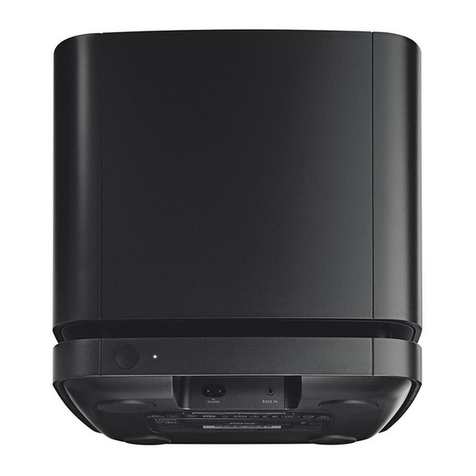
Bose
Bose Acoustimass 500 Instruction Manual

Bose
Bose Acoustimass 700 User manual
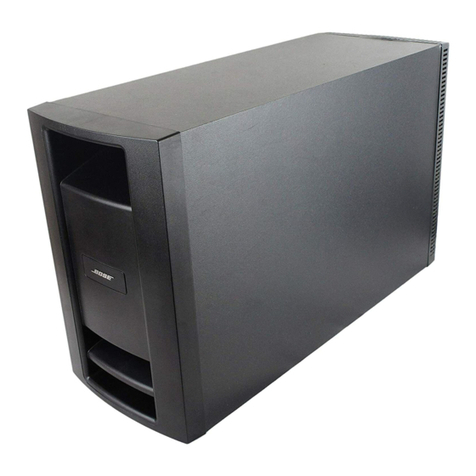
Bose
Bose Lifestyle PS28 Reference guide
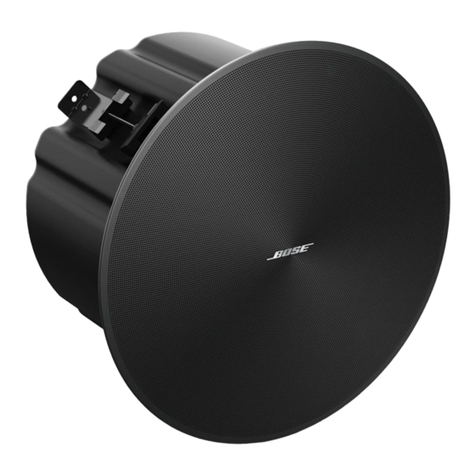
Bose
Bose DesignMax DM8C-SUB User manual

Bose
Bose Acoustimass 500 User manual
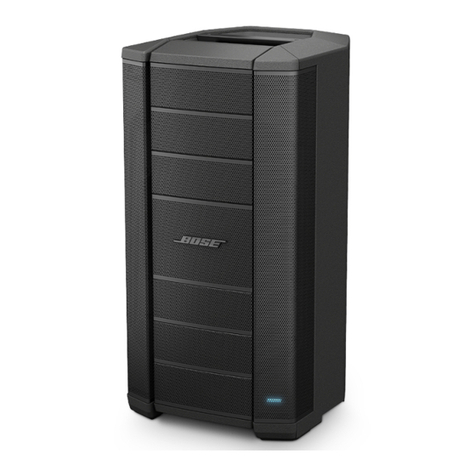
Bose
Bose F1 812 User manual
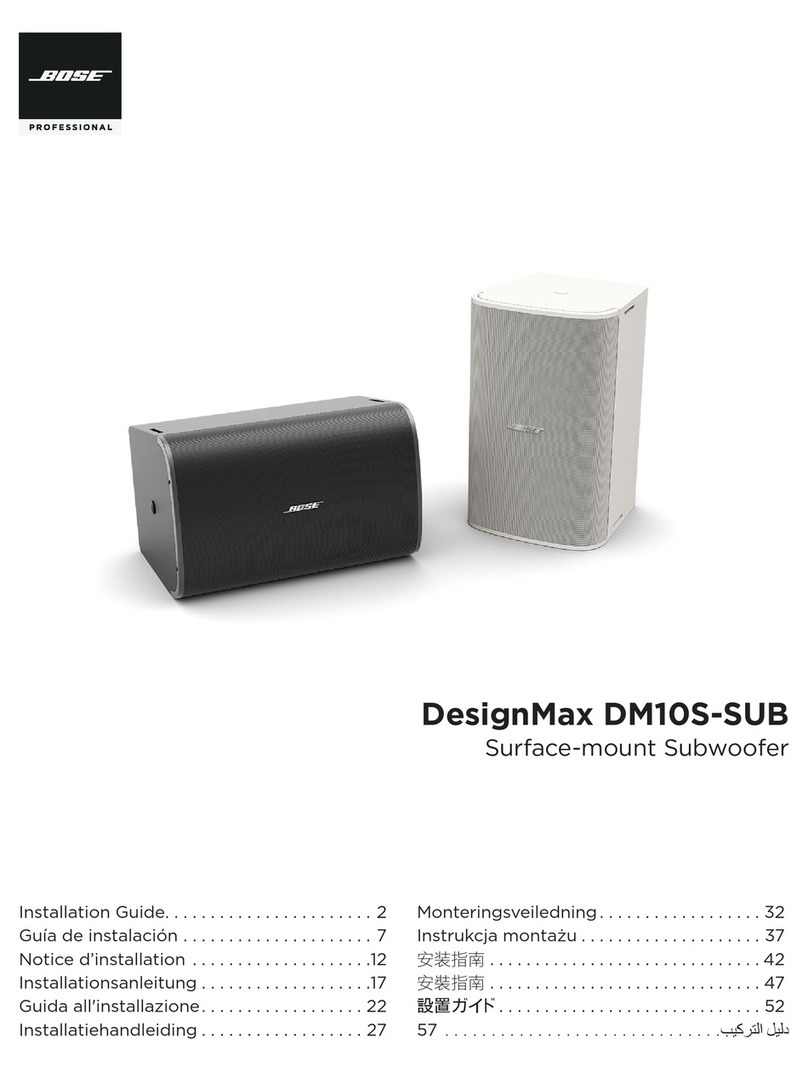
Bose
Bose DesignMax DM10S-SUB User manual

Bose
Bose Acoustimass 500 User manual
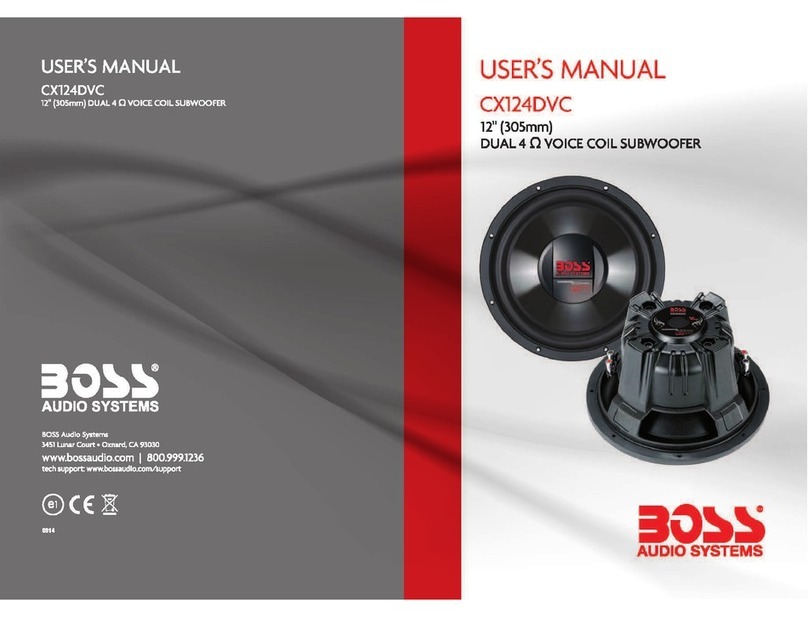
Bose
Bose CX124DVC User manual
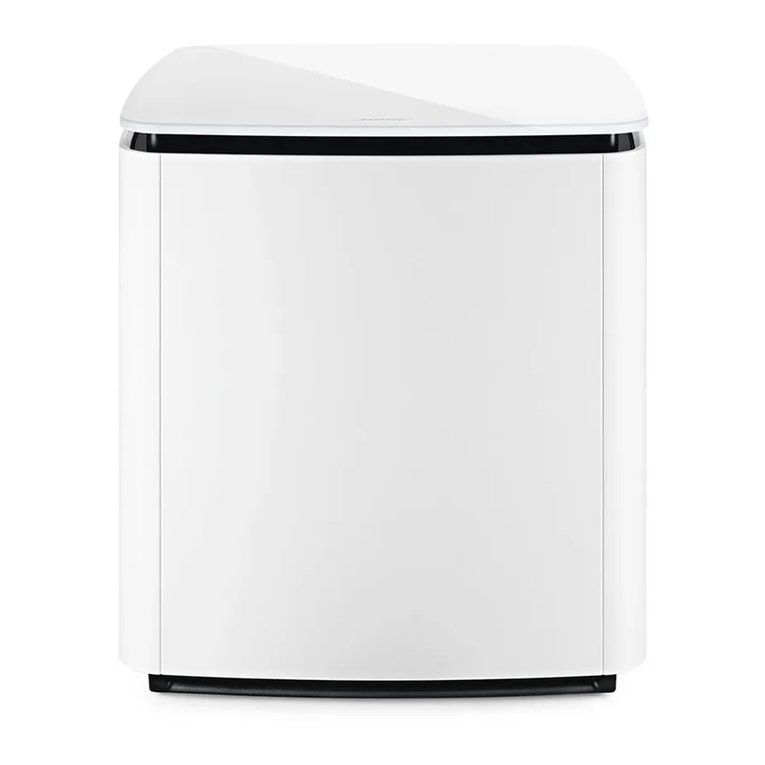
Bose
Bose Acoustimass 700 User manual

